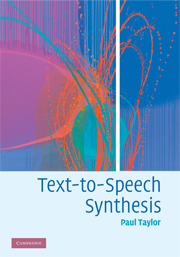Book contents
- Frontmatter
- Contents
- Foreword
- Preface
- 1 Introduction
- 2 Communication and language
- 3 The text-to-speech problem
- 4 Text segmentation and organisation
- 5 Text decoding: finding the words from the text
- 6 Prosody prediction from text
- 7 Phonetics and phonology
- 8 Pronunciation
- 9 Synthesis of prosody
- 10 Signals and filters
- 11 Acoustic models of speech production
- 12 Analysis of speech signals
- 13 Synthesis techniques based on vocal-tract models
- 14 Synthesis by concatenation and signal-processing modification
- 15 Hidden-Markov-model synthesis
- 16 Unit-selection synthesis
- 17 Further issues
- 18 Conclusion
- Appendix A Probability
- Appendix B Phone definitions
- References
- Index
10 - Signals and filters
Published online by Cambridge University Press: 25 January 2011
- Frontmatter
- Contents
- Foreword
- Preface
- 1 Introduction
- 2 Communication and language
- 3 The text-to-speech problem
- 4 Text segmentation and organisation
- 5 Text decoding: finding the words from the text
- 6 Prosody prediction from text
- 7 Phonetics and phonology
- 8 Pronunciation
- 9 Synthesis of prosody
- 10 Signals and filters
- 11 Acoustic models of speech production
- 12 Analysis of speech signals
- 13 Synthesis techniques based on vocal-tract models
- 14 Synthesis by concatenation and signal-processing modification
- 15 Hidden-Markov-model synthesis
- 16 Unit-selection synthesis
- 17 Further issues
- 18 Conclusion
- Appendix A Probability
- Appendix B Phone definitions
- References
- Index
Summary
This chapter introduces the fundamentals of the field of signal processing, which studies how signals can be synthesised, analysed and modified. Here, and for the remainder of the book, we use the term signal in a more specific sense than before, in that we take it to mean a waveform that represents a pattern of variation against time. This material describes signals in general, but serves as a precursor to the following chapters which describe the nature of speech signals and how they can be generated, manipulated and modified. This chapter uses the framework of digital signal processing, a widely adopted set of techniques used by engineers to analyse many types of signals.
Analogue signals
A signal is a pattern of variation that encodes information. Signals that encode the variation of information over time can be represented by a time waveform, which is often just called a waveform. Figure 10.1 shows an example speech waveform. The horizontal axis represents time and the vertical axis represents amplitude, hence the figure shows how the amplitude of the signal varies with time. The amplitude in a speech signal can represent diverse physical quantities: for example, the variation in air pressure in front of the mouth, the displacement of the diaphragm of a microphone used to record the speech or the voltage in the wire used to transmit the speech.
Information
- Type
- Chapter
- Information
- Text-to-Speech Synthesis , pp. 262 - 308Publisher: Cambridge University PressPrint publication year: 2009
